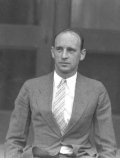|

Portrait of Fred E. Weick, 1936.

Fred Weick designed the W-1 with tricycle landing gear. It is shown here in the Full Scale Tunnel in March 1934.
|
Fred Weick
Fred Weick, born in 1899, was one of the nation's earliest aviation pioneers, working as an airmail pilot, research engineer, and aircraft designer. A contemporary of aviation legends Charles Lindbergh and Amelia Earhart, he did not receive the same attention as his more glamorous colleagues yet the contributions he brought to the country's struggling aircraft industry arguably outstripped any of his peers.
A 1922 graduate of the University of Illinois, he was one of the first university graduates to apply his degree to a career in aeronautics. Weick was also one of the first engineers hired by the original U.S. Air Mail Service. His efforts in the early 1920s to establish emergency fields for night-flying mail pilots were a major challenge.
Weick helped design the first wind tunnel devoted to full-scale propeller research and wrote a textbook on propeller design that became a classic. During that period, Weick worked for the National Advisory Committee for Aeronautics (NACA) at its Langley Aeronautical Laboratory, in Hampton, Virginia.
It was also at Langley that Weick headed the development of streamlined, low-drag engine cowling technology that was to advance aircraft performance dramatically. The NACA cowling first revolutionized civil air transport by making aircraft faster and more profitable. It also found application on the bombers and fighters of World War II. For this engineering breakthrough, he won the prestigious Collier Trophy for NACA in 1929.
The experimental airplane he built in the early 1930s demonstrated Weick's passion for safety. His goal was to make flying as easy and safe as driving the family auto. In addition to the integrated controls for ease of flying, he incorporated the tricycle landing gear that became standard on virtually all the world's aircraft including the Space Shuttle.
Later in the 1930s, he improved on that design with the Ercoupe, the two-seat, all-metal, low-wing aircraft that was so easy and safe to fly that many students mastered it in five hours or less. Half of the 6,000 Ercoupes built were still flying at the time of Weick's death. In February 1946, he received the Fawcett Aviation Award for the greatest contribution to the scientific advancement of private flying.
Weick joined Texas A&M University in 1948. There, he worked on the design and development of the Ag-1 crop duster, and designed the Ag-3, predecessor to Piper's PA-26 Pawnee series. He joined Piper in 1957 as director and chief engineer of their development center, remaining there until his retirement at age 70. In addition to the Pawnee, Weick co-designed Piper's Cherokee line of personal and business lightplanes.
Weick died July 8, 1993, in Vero Beach, Florida.
|



